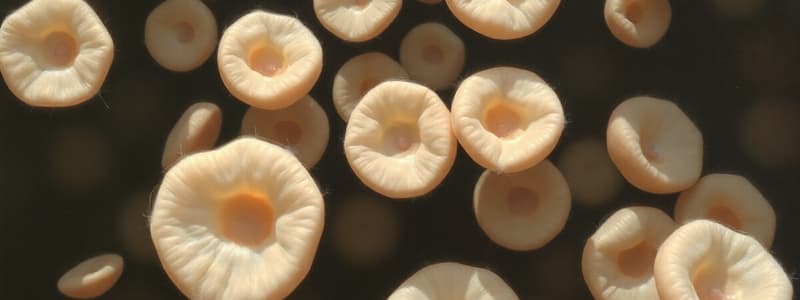Podcast
Questions and Answers
What is a key characteristic of white blood cells (WBC)?
What is a key characteristic of white blood cells (WBC)?
- They are larger than red blood cells
- They are produced in the liver
- They contain hemoglobin
- They have nuclei (correct)
Which statement is true regarding white blood cells?
Which statement is true regarding white blood cells?
- They are the most numerous type of blood cell
- They have a lifespan of several years
- They are devoid of hemoglobin (correct)
- They are responsible for oxygen transport
Which of the following is NOT a function of white blood cells?
Which of the following is NOT a function of white blood cells?
- Supporting immune function
- Fighting infections
- Producing antibodies
- Transporting nutrients (correct)
How do white blood cells differ from red blood cells?
How do white blood cells differ from red blood cells?
Why might the absence of hemoglobin in white blood cells be significant?
Why might the absence of hemoglobin in white blood cells be significant?
Flashcards
What are WBCs?
What are WBCs?
WBCs, also known as leukocytes, are a type of blood cell that have nuclei and lack hemoglobin.
What is the function of WBCs?
What is the function of WBCs?
WBCs are responsible for fighting infections and protecting the body from foreign invaders like bacteria, viruses, and parasites.
What are leukocytes?
What are leukocytes?
Leukocytes, or white blood cells, are a crucial component of the immune system responsible for defending the body against infections.
Do WBCs contain hemoglobin?
Do WBCs contain hemoglobin?
Signup and view all the flashcards
What is the significance of nuclei in WBCs?
What is the significance of nuclei in WBCs?
Signup and view all the flashcards
Study Notes
White Blood Cells (WBCs)
- WBCs, also known as leukocytes, are a crucial part of blood.
- They lack hemoglobin and have nuclei.
- The count ranges from 4,000 to 11,000/mm³.
- Less than 1% of total blood volume.
Types of WBCs
-
Granulocytes: Contain granules, lobed nuclei.
- Neutrophils: 40-70%, 10-15 µm diameter.
- Eosinophils: 1-4%, 10-15 µm diameter.
- Basophils: 0-2%, 10-15 µm diameter.
-
Agranulocytes: Few or no granules, large spherical nuclei.
- Lymphocytes: 20-40%, 7-10 μm (small) or 11-15 µm(large) diameter.
- Monocytes: 3-8%, 14-18 µm diameter.
Leukopoiesis
- WBC production occurs in:
- Bone marrow (granulocytes, monocytes, some lymphocytes)
- Lymph tissue (lymphocytes, plasma cells)
- Stimulators: Chemical messengers (e.g., Interleukins, Colony-Stimulating Factors (CSFs))
- Steps: Hemocytoblasts differentiate into myeloid and lymphoid stem cells. These then develop into various WBC types.
Leukocytosis/Leukopenia
- Leukocytosis: Increased WBC count (above 11,000/mm³).
- Physiological causes: Exercise, adrenaline injections, meals, hot baths, fatigue.
- Pathological causes: Infections, hemorrhage, post-operative, tissue damage, coronary thrombosis.
- Leukopenia: Decreased WBC count (below 4000/mm³).
- Causes: Drug toxicity, typhoid fever, vitamin B12/folic acid deficiency, bone marrow problems.
- Leukemia: A malignant disease with uncontrolled WBC production (up to 50,000/mm³).
Neutrophils
- Life span: 6-12 hours
- First line of defense against bacteria and foreign particles.
- Crucial for phagocytosis and inflammation.
- Important characteristics: Margination, diapedesis, ameboid movement, chemotaxis, opsonization, phagocytosis.
Degranulation
- Lysosomal enzymes in neutrophils fuse with phagocytic vesicles to destroy bacteria.
- Neutrophils are then removed by monocyte macrophages.
Eosinophils
- Makeup: 1-4%
- Function: Mild phagocytic action, response to parasites, allergic reactions, blood clot lysis.
Basophils
- Makeup: 0-2%
- Synthesize/store: Histamine (allergic/inflammatory mediator), heparin (anticoagulant).
Mast Cells
- Similar to basophils, present in tissues (e.g., skin).
- Play role in allergic reactions.
- IgE binds to mast cells; antigen binding triggers histamine release.
Monocytes
- Largest WBCs.
- Function: Develop into tissue macrophages, phagocytose foreign substances, bacteria, damaged cells, and debris.
Lymphocytes
- Key cells of immunity.
- Major types: T cells (Th cells and Tc cells), B cells.
- Memory T cells: Recognize and respond rapidly to subsequent exposures to the same antigen.
T Lymphocytes
- Helper T cells: Most numerous of T cells. Crucial for overall immune response.
- Cytotoxic T cells (Killer T cells): Directly kill infected or cancerous cells.
- Suppressor T cells (Regulatory T cells): Limit the immune system's activity, preventing autoimmune diseases.
Antibodies(Immunoglobulins)
- Soluble proteins produced by activated B cells, important in immune response.
- Types: IgG, IgM, IgA, IgE, IgD.
- IgG is most prevalent. Crosses the placenta.
- IgM is large, remains in blood vessels.
- IgA is found in mucosal secretions.
- IgE is involved in allergic reactions, defense against parasites.
- IgD is found on B cell surface.
Innate Immunity
- Non-specific defense.
- Mechanisms: Mechanical barriers (skin, mucous membranes), chemical barriers (salivary enzymes, acid in stomach), phagocytosis, natural killer cells.
Acquired Immunity
- Specific defense.
- Two types: Humoral (antibodies) and cellular (T cells).
- Characterized by having memory cells.
Tissue Macrophages
- Some monocytes become attached to tissue.
- Examples: Kupffer cells (liver), macrophages of spleen, lung, bone marrow, brain, kidney.
- Similar functions to mobile macrophages. Filter out bacteria, viruses, and necrotic material from tissues, blood, and lymph.
Immunity
- Ability of the body to resist organisms/toxins that cause damages to tissues or organs.
Autoimmune Disorders
- Occurs when the immune system mistakenly attacks the body's own tissues.
- Examples: Multiple sclerosis, myasthenia gravis, rheumatoid arthritis.
Studying That Suits You
Use AI to generate personalized quizzes and flashcards to suit your learning preferences.



